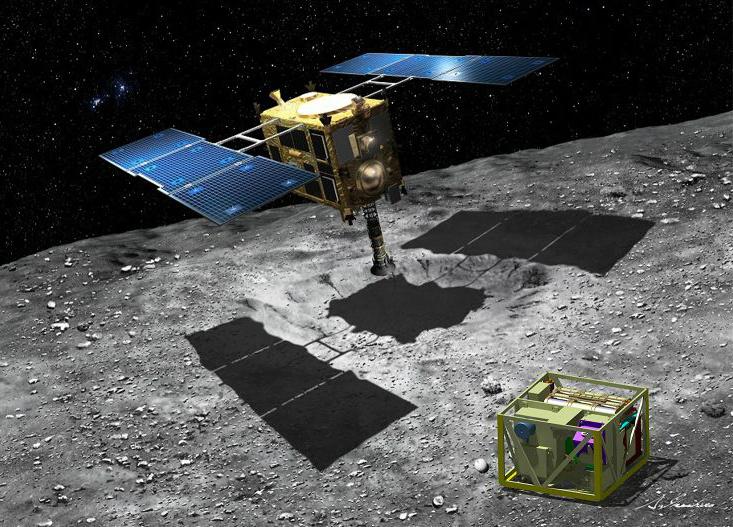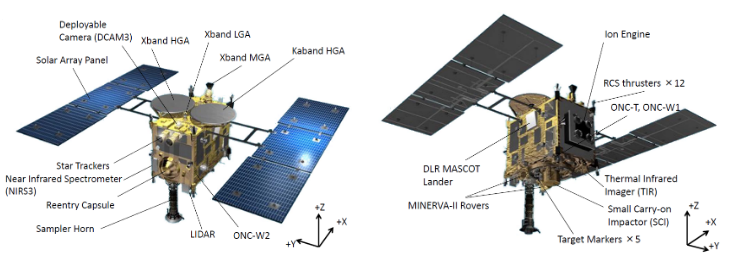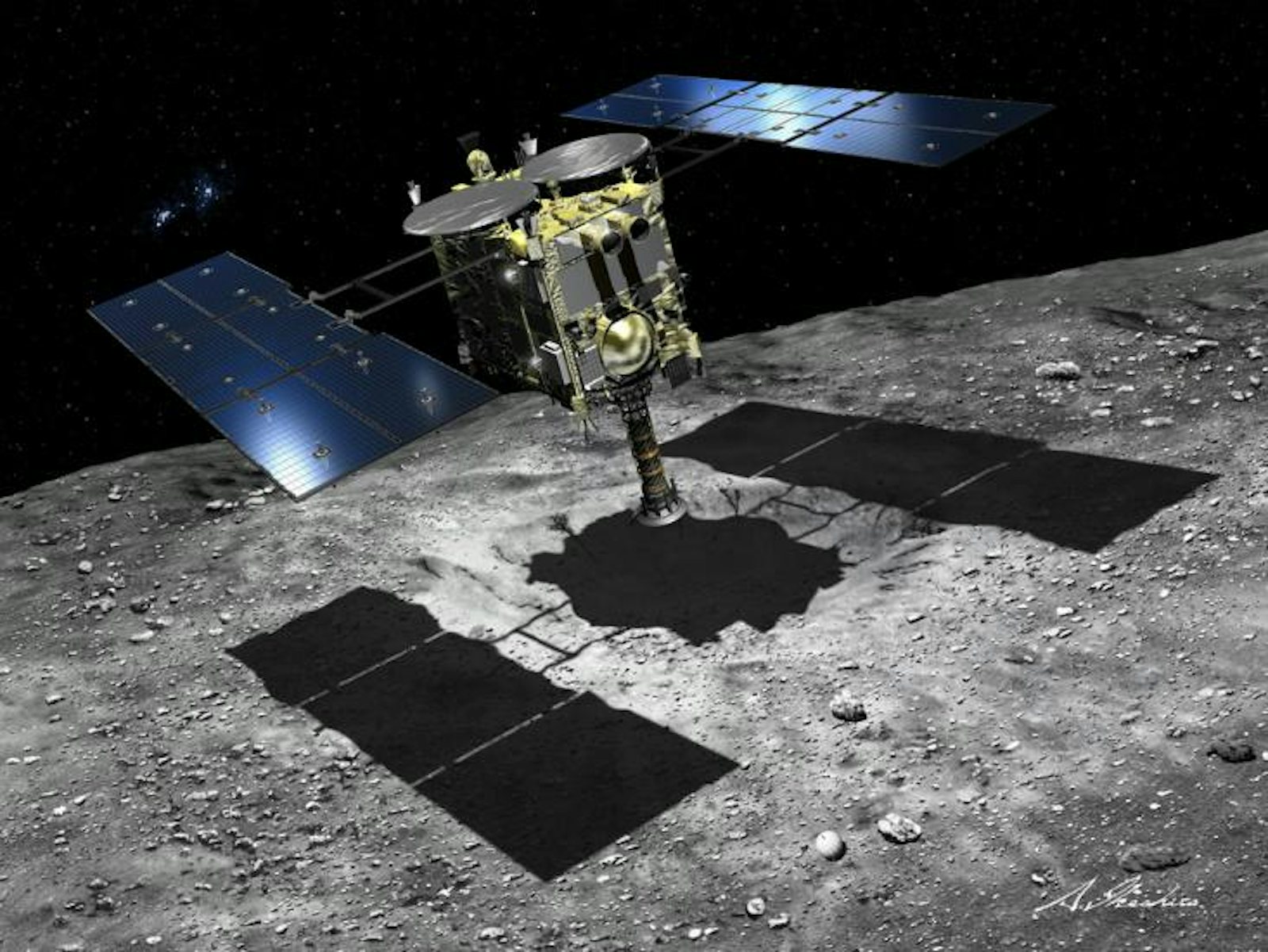
From mythological tales to the exploration of Mars, humans have hunted the heavens for the answers to life. Yet never before has there been an attempt quite as bold as the Hayabusa2 mission.
Launched at the start of last month by the Japan Aerospace Exploration Agency (JAXA), Hayabusa2 aims to see if the beginnings of life can be traced to the asteroids. The asteroids are rocky leftovers from planet formation, akin to the inexplicable spare parts left over after the assembly of Ikea furniture. The majority circle the Sun out past Mars (the fourth planet from the Sun), though Hayabusa2’s target rock is currently orbiting between the red planet and Earth (third from the Sun).
The distances involved in space travel mean that it will take until mid-2018 for Hayabusa2 to catch up with asteroid 1999 JU3. But that’s barely a prelude to what the craft has in store. Once it draws up to its target, Hayabusa2 is set to engage in a shockingly challenging series of steps to reveal the asteroid’s past and, perhaps, the origin of all life in our solar system. If the Philae spacecraft’s celebrated landing on a comet was like throwing a dart into a dartboard a continent away, then Hayabusa2 aims to pack a team of mobile, miniature scientists into the dart, have them explore the dartboard—and then pilot the dart back home.
The mission’s main job is to search for signs of water and amino acids—building blocks of proteins and essential ingredients of life—that match those found in living things on Earth. If it does, then we’ll have evidence that asteroids sent both the medium critical for life and the seeds with which to begin it.
Since Hayabusa2’s target asteroid is only one kilometer across, its gravity is too weak to hold liquid water. But an observation from Earth has spied the presence of water-containing clays, suggesting the asteroid was once part of a larger object that had enough gravity to hold water, at least in its interior, but then disintegrated. Hayabusa2 plans to survey the rock and locate these clays. Then it is going to land.
Rather than perform a complete analysis in space, Hayabusa2 will gather samples from the asteroid to return to Earth. This round-trip ticket means the spacecraft itself needs to reach the asteroid’s surface—it needs to physically grab the samples to be brought back. It is a landing fraught with peril, since communication between the spacecraft and Earth will too delayed for human assistance. Hayabusa2 must land on its own.
1: MAKING CONTACT
To reach the surface safely, Hayabusa2 will drop a reflective target marker before it lands. Filled with small balls to counter rolling, the marker will land like a beanbag on the asteroid surface and reflect light to help position the descending spacecraft. As Hayabusa2 drops to below 30 meters (100 feet), the spacecraft will use four lasers to align itself as precisely as possible to the slope of the landing site. In the asteroid’s weak gravitational grip, the brief, final touchdown needs to be gentle; if it hits too hard, the lander could bounce right out into space. Yet, the craft must also kick up enough material for collection. The solution is for Hayabusa2 to shoot the asteroid with a bullet.
2: BULLET TIME
The five-gram (1/6 of an ounce) bullet will hit the asteroid surface at 300 meters persecond (670 miles per hour), kicking up small rocks that can be gathered in Hayabusa’s sample container via a long horn.
Even with the huge amount of planning that went into the mission, the risks in a surface landing are great. As its name suggests, Hayabusa2 had a predecessor, which visited a different asteroid between 2003–2010. During this first spacecraft’s landing, one of the guidance lasers found an obstacle at the landing site. Rather than terminating the operation and returning to space, Hayabusa continued with its descent and bounced (as did Rosetta’s Philae lander nine years later). It returned to the asteroid’s surface but proceeded to remain there for 30 minutes, rather than the intended seconds. “This was really dangerous,” explains Shogo Tachibana, associate professor at Hokkaido University and a lead scientist on the Hayabusa2 team. “On the surface of the asteroid, the temperature is very high [in danger of reaching 100 Celsius] and it’s not good for the spacecraft to be there long.”
While Hayabusa was able to leave the asteroid and attempt a second landing, the bullet for stirring up the surface rocks failed to fire. This left everyone anxious about how much material had been collected.
This time, the Hayabusa2 team are confident in the firing mechanism. Still, in case of unplanned malfunctions, they also have a back-up plan.
3: TOOTHY COLLECTOR
The bottom edge of the horn used to collect the surface material is lined with a comb of teeth that turn up at the ends. As Hayabusa2 rises from the surface, these teeth will lift any loosely packed surface rocks into the air. The spacecraft will then slow down, causing the faster-moving debris to drift into the sample jar.

4: LONG-TERM PRESENCE
Hayabusa2 cannot dawdle on the asteroid surface, but it will leave behind a deputy. The MASCOT (Mobile Asteroid Surface SCout) lander, developed by the same German and French team that designed Philae, will analyze the asteroid at close quarters. With its wide-angle camera, MASCOT can photograph the asteroid’s layout around the tiny rocks Hayabusa2 is taking home. It will also dispatch a trio of small rovers to further explore the rocky mini-world, providing geological information from further afield and testing mobility in the asteroid’s weak gravitational environment.
5: REPEAT VISITOR
Meanwhile, back in space, Hayabusa2 will prepare to do the landing all over again. Twice.
The second and third touchdowns will enable Hayabusa2 to gather rock samples from different locations. On the third descent, Hayabusa2 is aiming to gather material from beneath the asteroid’s surface. For that, it needs an impactor larger than a five-gram bullet.
6: ONE BIG BULLET
The small carry-on impactor (SCI) is a flat, 2.5-kilogram (5.5-pound) copper disk that floats in the weak gravity of the asteroid. After it’s dispatched from the spacecraft, an onboard timer will set off an attached, 4.5-kilogram (10-pound) explosive charge, distorting the disk into a bullet that rams into the asteroid’s surface at two kilometers per second (4,500 miles per hour), creating a hole around 10 meters (33 feet) in diameter. The delay before the explosion gives Hayabusa2 time to duck behind the asteroid out of harm’s way from the explosive debris. Since no one wants to miss the fun of an explosion, Hayabusa2 will dispatch a detachable camera to watch the proceedings. You can see the dramatic process in this animation from JAXA:
Once it is safely clear from the explosion, Hayabusa2 will undertake its final descent to gather material.
7: COMIN’ HOME
After three surface landings, Hayabusa2 lifts away from the asteroid for the last time and points towards Earth. The one-year return journey is due to deposit the spacecraft in the Australian outback in the final weeks of 2020, where its precious cargo will be whisked away for analysis. Buried within these rocky grains may possibly be water and amino acids that are a match to those on Earth.
Water is essential to life, and our planet have a good amount of it, but exactly where it came from remains a mystery. Due to our proximity to the Sun, our planet probably formed as a dry world; the rocky particles that crashed together to build up the Earth were too hot to contain any ice. The water that makes up our oceans was likely delivered through later impacts from ice-laden meteorites. The origin of these rocks is highly debated, but evidence is stacking up that they may be from asteroids, as opposed to the more distant comets.
Still more intriguingly, research has suggested that amino acids, a key ingredient in proteins and all known life, form when water is present on asteroids. What is more, the amino acids found on asteroids appear to be left-handed, like all of those seen in life on Earth. Like your left and right hands, amino acids can be formed with two mirror-image structures. When made in the laboratory, equal numbers of left- and right-handed amino acids are produced. Yet, for unknown reasons, Earth’s biology strongly favors the left-handed version. If Hayabusa2 confirms the presence of left-handed amino acids on asteroid 1999 JU3, that suggest that life here uses them because that’s what was brought here by asteroids.
That rock hurtling through space today may be a twin of ones that hit the dry Earth billions of years ago, and gave it the keys to life. If Hayabusa2 completes its daunting mission, we may soon know for sure.
Elizabeth Tasker is an assistant professor at Hokkaido University. She keeps her own blog at girlandkat.com and tweets about planets and life in Japan @girlandkat.


























